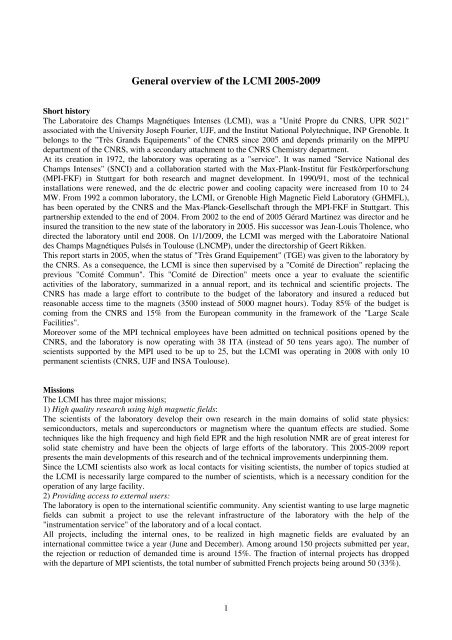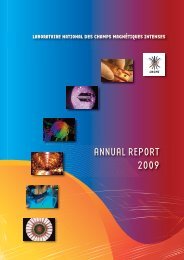Laboratoire National des Champs Magnétiques Pulsés CNRS – INSA
Laboratoire National des Champs Magnétiques Pulsés CNRS – INSA
Laboratoire National des Champs Magnétiques Pulsés CNRS – INSA
You also want an ePaper? Increase the reach of your titles
YUMPU automatically turns print PDFs into web optimized ePapers that Google loves.
General overview of the LCMI 2005-2009<br />
Short history<br />
The <strong>Laboratoire</strong> <strong>des</strong> <strong>Champs</strong> <strong>Magnétiques</strong> Intenses (LCMI), was a "Unité Propre du <strong>CNRS</strong>, UPR 5021"<br />
associated with the University Joseph Fourier, UJF, and the Institut <strong>National</strong> Polytechnique, INP Grenoble. It<br />
belongs to the "Très Grands Equipements" of the <strong>CNRS</strong> since 2005 and depends primarily on the MPPU<br />
department of the <strong>CNRS</strong>, with a secondary attachment to the <strong>CNRS</strong> Chemistry department.<br />
At its creation in 1972, the laboratory was operating as a "service". It was named "Service <strong>National</strong> <strong>des</strong><br />
<strong>Champs</strong> Intenses" (SNCI) and a collaboration started with the Max-Plank-Institut für Festkörperforschung<br />
(MPI-FKF) in Stuttgart for both research and magnet development. In 1990/91, most of the technical<br />
installations were renewed, and the dc electric power and cooling capacity were increased from 10 to 24<br />
MW. From 1992 a common laboratory, the LCMI, or Grenoble High Magnetic Field Laboratory (GHMFL),<br />
has been operated by the <strong>CNRS</strong> and the Max-Planck-Gesellschaft through the MPI-FKF in Stuttgart. This<br />
partnership extended to the end of 2004. From 2002 to the end of 2005 Gérard Martinez was director and he<br />
insured the transition to the new state of the laboratory in 2005. His successor was Jean-Louis Tholence, who<br />
directed the laboratory until end 2008. On 1/1/2009, the LCMI was merged with the <strong>Laboratoire</strong> <strong>National</strong><br />
<strong>des</strong> <strong>Champs</strong> <strong>Magnétiques</strong> <strong>Pulsés</strong> in Toulouse (LNCMP), under the directorship of Geert Rikken.<br />
This report starts in 2005, when the status of "Très Grand Equipement" (TGE) was given to the laboratory by<br />
the <strong>CNRS</strong>. As a consequence, the LCMI is since then supervised by a "Comité de Direction" replacing the<br />
previous "Comité Commun". This "Comité de Direction" meets once a year to evaluate the scientific<br />
activities of the laboratory, summarized in a annual report, and its technical and scientific projects. The<br />
<strong>CNRS</strong> has made a large effort to contribute to the budget of the laboratory and insured a reduced but<br />
reasonable access time to the magnets (3500 instead of 5000 magnet hours). Today 85% of the budget is<br />
coming from the <strong>CNRS</strong> and 15% from the European community in the framework of the "Large Scale<br />
Facilities".<br />
Moreover some of the MPI technical employees have been admitted on technical positions opened by the<br />
<strong>CNRS</strong>, and the laboratory is now operating with 38 ITA (instead of 50 tens years ago). The number of<br />
scientists supported by the MPI used to be up to 25, but the LCMI was operating in 2008 with only 10<br />
permanent scientists (<strong>CNRS</strong>, UJF and <strong>INSA</strong> Toulouse).<br />
Missions<br />
The LCMI has three major missions;<br />
1) High quality research using high magnetic fields:<br />
The scientists of the laboratory develop their own research in the main domains of solid state physics:<br />
semiconductors, metals and superconductors or magnetism where the quantum effects are studied. Some<br />
techniques like the high frequency and high field EPR and the high resolution NMR are of great interest for<br />
solid state chemistry and have been the objects of large efforts of the laboratory. This 2005-2009 report<br />
presents the main developments of this research and of the technical improvements underpinning them.<br />
Since the LCMI scientists also work as local contacts for visiting scientists, the number of topics studied at<br />
the LCMI is necessarily large compared to the number of scientists, which is a necessary condition for the<br />
operation of any large facility.<br />
2) Providing access to external users:<br />
The laboratory is open to the international scientific community. Any scientist wanting to use large magnetic<br />
fields can submit a project to use the relevant infrastructure of the laboratory with the help of the<br />
"instrumentation service" of the laboratory and of a local contact.<br />
All projects, including the internal ones, to be realized in high magnetic fields are evaluated by an<br />
international committee twice a year (June and December). Among around 150 projects submitted per year,<br />
the rejection or reduction of demanded time is around 15%. The fraction of internal projects has dropped<br />
with the departure of MPI scientists, the total number of submitted French projects being around 50 (33%).<br />
1







